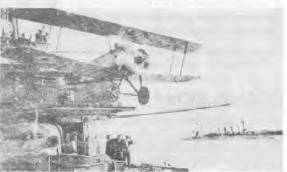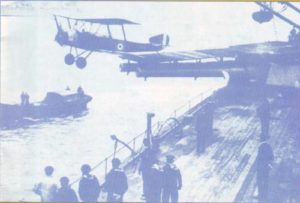- Author
- Stevens, Errol
- Subjects
- Naval Aviation, History - WW1
- Tags
-
- RAN Ships
- HMAS Swan II, HMAS Brisbane I, HMAS Australia I, HMAS Melbourne I
- Publication
- December 1995 edition of the Naval Historical Review (all rights reserved)
Apart from those paying their own fare to England to join the RNAS there were a number of Australians already in the Royal Navy (RN) who transferred to the RNAS, and others who were working or visiting overseas at the outbreak of WWI. A number even paid for private flying lessons to increase their chances of being selected as a pilot. At one stage nearly 50% of the RNAS aircrew were from the Dominions or Colonies. They included men such as R. COLLISHAW, a Canadian with 62 victories – the 3rd highest score of any of the British Empire forces in WWI. Another RNAS Canadian A. R. Brown was credited by some sources with shooting down M. von RICHTHOFEN, the German “Red Baron” who was the highest scorer from any of the nations involved in WWI with 80 victories. For background information, the highest scoring British Empire ace in WWI was the RFC’s E. MANNOCK from U.K. with 73 victories followed closely by Canadian W.A. BISHOP also of the RFC with 72 victories. Top WWI USA ace was E. RICKENBACKER with 26 victories.
BROWN’s claim to have shot down RICHTHOFEN is disputed by Australian ground forces who machine gunned his plane as it passed low over their position in pursuit of a British plane, with BROWN chasing RICHTHOFEN.
Top AFC ace in WWI was A.H. COBBY with 29 victories whilst top RAAF ace in WWII was C. R. CALDWELL with 28½. The AFC’s first overseas operational activity was to send a half Flight to the Middle East in 1915. It had four operational squadrons and about 3.000 personnel overseas by 1918.
AIRCRAFT
WWI saw vast changes in the use and roles of military aircraft. In 1914 their maximum speed was about 70 miles per hour. They were intended mainly for reconnaissance and carried no weapons or wireless equipment. As the war progressed aircraft started carrying machine guns, then synchronising gear so they could fire through the propeller arc, carrying bombs and using wireless for gunfire spotting and observation. By 1918 some aircraft achieved a speed of 140 miles an hour, double that of 1914.
The most successful fighter in WWI of any nation in terms of numbers of enemy aircraft destroyed was the British Sopwith Camel with nearly 1,300 victims. It came into operational service in 1917 and was originally produced for the RNAS but soon adopted by the RFC and other countries.

(Photo: Navy)
Whilst the development of the aircraft is outside the scope of this article, the RNAS was responsible for flying from RAN ships. From April to June 1917 HMAS BRISBANE embarked a Sopwith Baby seaplane. In December 1917 aircraft were successfully flown off from HMAS SYDNEY (cruiser) and HMAS AUSTRALIA (battle cruiser) and later from HMAS MELBOURNE (cruiser).

(Photo: NAVY)
The cruisers had a fixed platform built above their forward gun turret and turned into the wind to launch their single aircraft. The battle cruiser had platforms on top of P and Q turrets which turned with the turrets, and carried two aircraft, normally a single seater fighter such as a Sopwith Pup or Camel, and a two seater reconnaissance such as a Sopwith 1½ Strutter. In those days the main guns in turrets had a very limited elevation. If out of range of land, recovery of other than seaplanes was by ditching alongside – hazardous for the pilot and the aircraft was a write off.




